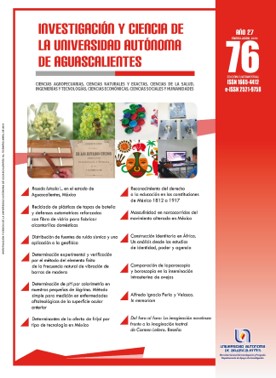Determination of pH by colorimetry in small tear samples. Simple method for pH measuring in ophthalmological diseases of the anterior ocular surface
DOI:
https://doi.org/10.33064/iycuaa2019761790Keywords:
bromothymol blue, anterior ocular surface, tear, pHAbstract
There are no simple methods in clinical practice to quantify tear pH. Our objective was to standardize a method for the determination of pH in small tear samples of patients. A colorimetric scale was constructed in a pH range of 6 to 8.0 using bromothymol blue as indicator, with 0.1M KH2PO4 (constant) and ascending volumes of 0.1M NaOH. The method was validated in 20 uL of tear of 73 subjects, in whom it was possible to distinguish changes in the pH from 0.2 in 0.2 in a range of 6.0 to 8.0 with a coefficient of intrasubject variation of 0.8 to 4.0%. The method presented here is precise, with low inter-assay variation. This, combined with its simplicity, low cost and small sample volume, make it an alternative for monitoring the pH of the tear either, in the patient's bed or in primary care.
Downloads
References
• Abelson, M. B., Sadun, A. A., Udell, I. J., & Weston, J. H. (1980). Alkaline tear pH in ocular rosácea. American Journal of Ophthalmology, 90(6), 866-869. doi: 10.1016/S0002-9394(14)75203-1
• Avetisov, S. E., Safonova, T. N., Novikov, I. A., Pateiuk, L. S., & Griboedova, I. G. (2014). [Ocular surface acidity and buffering system (by studying the conjunctival sac)]. Vestnik Oftalmologii, 130(5), 5-10.
• Bergmanson, J. P. G., Söderberg, P. G., & Estrada, P. (1987). Comparison between the measure and desirable quality of hydrogel extended wear contact lenses. Acta Ophtalmologica, 65(4), 417-423. doi: 10.1111/j.1755-3768.1987.tb07017.x.
• Carney, L. G., & Hill, R. M. (1976). Human tear pH: diurnal variations. Arch Ophthalmol, 94(5), 821-824. doi:10.1001/archopht.1976.03910030405011
• Carney, L. G., Mauger, T. F., & Hill, R. M. (1989). Buffering in human tears: pH responses to acid and base challenge. Investigative Ophthalmology and Visual Science, 30(4), 747-754.
• __________ (1990). Tear buffering in contact lens wearers. Acta Ophthalmologica (Copenhagen), 68(1), 75-79. doi: 10.1111/j.1755-3768.1990.tb01653.x
• Coles, W. H., & Jaros, P. A. (1984). Dynamics of ocular surface pH. British Journal of Ophthalmology, 68(8), 549-552. doi: 10.1136/bjo.68.8.549
• Fleiszig, S. M., Zaidi, T. S., Ramphal, R., & Pier, G. B. (1994). Modulation of Pseudomonas aeruginosa adherence to the corneal surface by mucus. Infection and Immunity, 62(5), 1799-1804.
• Holly, F. J., & Lemp, M. A. (1977). Tear physiology and dry eyes. Survey of Ophthalmology, 22(2), 69-87. doi: 10.1016/0039-6257(77)90087-X
• Iwata, S. (1973). Chemical composition of the aqueous phase. En F. J. Holly, & M. A. Lemp (Eds.), The Preocular Tear Film and Dry Eye Syndromes (pp. 29-46). Boston, US: Little, Brown and Company.
• Izquierdo-Sañudo, M. C., Peral-Fernández, F., Plaza-Pérez, A., & Trotino-Núñez, M. D. (2003). Evolución histórica de los principios de la Química (pp. 353-371). Madrid: Ediciones UNED.
• Longwell, A., Birss, S., Keller N. & Moore, D. (1976). Effect of topically applied pilocarpine on tear film pH. Journal of Pharmaceutical Sciences, 65(11), 1654-1657. doi: 10.1002/jps.2600651123
• Machin, D., Campbell, M. J., Tan, S. B., & Tan, S. H. (2009). Sample size tables for clinical studies. UK: John Wiley & Sons.
• Motolko, M., & Breslin, C. W. (1981). The effect of pH and osmolarity on the ability of tolerate artificial tears. American Journal of Ophthalmology, 91(6), 781-784. doi: 10.1016/0002-9394(81)90012-X
• Murube, J., Paterson, A., & Murube, E. (1996). Classification of artificial tears. En D. A. Sullivan, D. A. Dartt, & M. A. Meneray (Eds.), Lacrimal Gland, Tear Film, and Dry Eye Syndromes 2 (pp. 693-704). Springer Science.
• Pinna, A., Usai, D., Sechi, L. A., Carta, A., & Zanetti, S. (2011). Detection of virulence factors in Serratia strains isolated from contact lens-associated corneal ulcers. Acta Ophthalmology, 89(4), 382-387. doi: 10.1111/j.1755-3768.2009.01689.x
• Rahman, M. Q., Chuah, K. S., Macdonald, E. C., Trusler, J. P. M., & Ramaesh, K. (2012). The effect of pH, dilution, and temperature on the viscosity of ocular lubricants-shift in rheological parameters and potential clinical significance. Eye (London), 26(12), 1579-1584. doi:10.1038/eye.2012.211
• Sullivan, A., Dartt, D. A., & Meneray, M. A. (Eds.). (1996). Lacrimal gland, tear film, and dry eye syndromes 2. Springer Science.
• Thygesen, J. E. M., & Jensen, O. L. (1987). pH changes of the tear fluid in the conjunctival sac during postoperative inflammation of the human eye. Acta Ophthalmologica, 65(2), 134-136. doi: 10.1111/j.1755-3768.1987.tb06990.x
• Yetisen, A. K., Jiang, N., Tamayol, A., Ruiz-Esparza, G. U., & Zhang, Y. (2017). Paper-based microfluidic system for tear electrolyte analysis. Lab on a Chip, 17(6), 1137-1148. doi: 10.1039/C6LC01450J
Downloads
Published
How to Cite
License
Las obras publicadas en versión electrónica de la revista están bajo la licencia Creative Commons Atribución-NoComercial-CompartirIgual 4.0 Internacional (CC BY-NC-SA 4.0)









